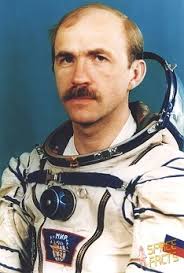Aleksandr Poleshchuk
Russian - (RFSA)
Retired
Date of Birth: Oct. 30, 1953
Age: 72
Aleksandr Fyodorovich Poleshchuk (Russian: Александр Фёдорович Полещук, born October 30, 1953) is a Russian cosmonaut. In February 1989 he was selected as a test cosmonaut candidate (1989 Cosmonaut Candidates Class, Group 14, Civil Specialists). From September 1989 to January 1991 he underwent the complete course of general space training and was qualified as a test cosmonaut, and then till March 1992 he undertook advanced training for the Soyuz-TM transport vehicle and Mir station flight. In 1992 he was selected as the backup flight engineer of the Soyuz TM-15 joint Russian-French mission, and consequently nominated as the flight engineer of the prime crew of Soyuz TM-16. In space from January 24 to July 22, 1993, he participated in a 179-day space flight with Gennady Manakov. During the flight he performed two EVAs totaling 9 hours and 58 minutes. Also testing of the androgynous peripheral docking subassembly of the Kristall module was performed.
Soyuz-U2 | Soyuz TM-16
Soviet Space Program | RussiaBaikonur Cosmodrome, Republic of Kazakhstan
Jan. 24, 1993, 5:58 a.m.
Status: Success
Mission:
Soyuz TM-16 was the 16th mission and the 13th long-duration expedition to Mir space station. The mission began on January 24, 1993, 05:58:05 UTC, launching Commander Gennadi Manakov and Flight Engineer Alexander Poleshchuk into orbit. They docked with Mir two days later. During their stay there, cosmonauts performed EVAs, various station repair and maintenance tasks, and carried out scientific experiments in materials research, space technology, astrophysics and earth observation. One of the experiments was the deployment of a 20-m foil reflector, which was a test of a future solar reflector designed to illuminate regions on the Earth's surface. Station crew was visited by several Progress resupply spacecrafts, and welcomed aboard the Soyuz TM-17 crew. The mission concluded with a safe landing back on Earth on July 22, 1993, 06:41:50 UTC.
Low Earth OrbitThe Roscosmos State Corporation for Space Activities, commonly known as Roscosmos, is the governmental body responsible for the space science program of the Russian Federation and general aerospace research. Soyuz has many launch locations the Russian sites are Baikonur, Plesetsk and Vostochny however Ariane also purchases the vehicle and launches it from French Guiana.
Long March 4B
Ziyuan-3-04
Launch Complex 9 - Taiyuan Satellite Launch Center, People's Republic of ChinaThe ZY-3 (Ziyuan-3, 'Resource-3') series represents China's first high-resolution, stereoscopic mapping satellites for civilian use. The second sa…
Falcon 9
Starlink Group 6-82
Space Launch Complex 40 - Cape Canaveral SFS, FL, USAA batch of 29 satellites for the Starlink mega-constellation - SpaceX's project for space-based Internet communication system.
Falcon 9
Starlink Group 15-12
Space Launch Complex 4E - Vandenberg SFB, CA, USAA batch of 27 satellites for the Starlink mega-constellation - SpaceX's project for space-based Internet communication system.
Electron
Raise and Shine (RAISE-4)
Rocket Lab Launch Complex 1B - Rocket Lab Launch Complex 1, Mahia Peninsula, New ZealandRAISE-4 (RApid Innovative payload demonstration Satellite-4) is a Japan Aerospace Exploration Agency (JAXA) satellite for on-orbit demonstrations of …
Kuaizhou 11
DEAR-5
Launch Area 95A - Jiuquan Satellite Launch Center, People's Republic of ChinaDEAR-5 is a commercial in-orbit payload and micro-gravity experiments hosting spacecraft developed by Chinese commercial company AZSPACE for various …



